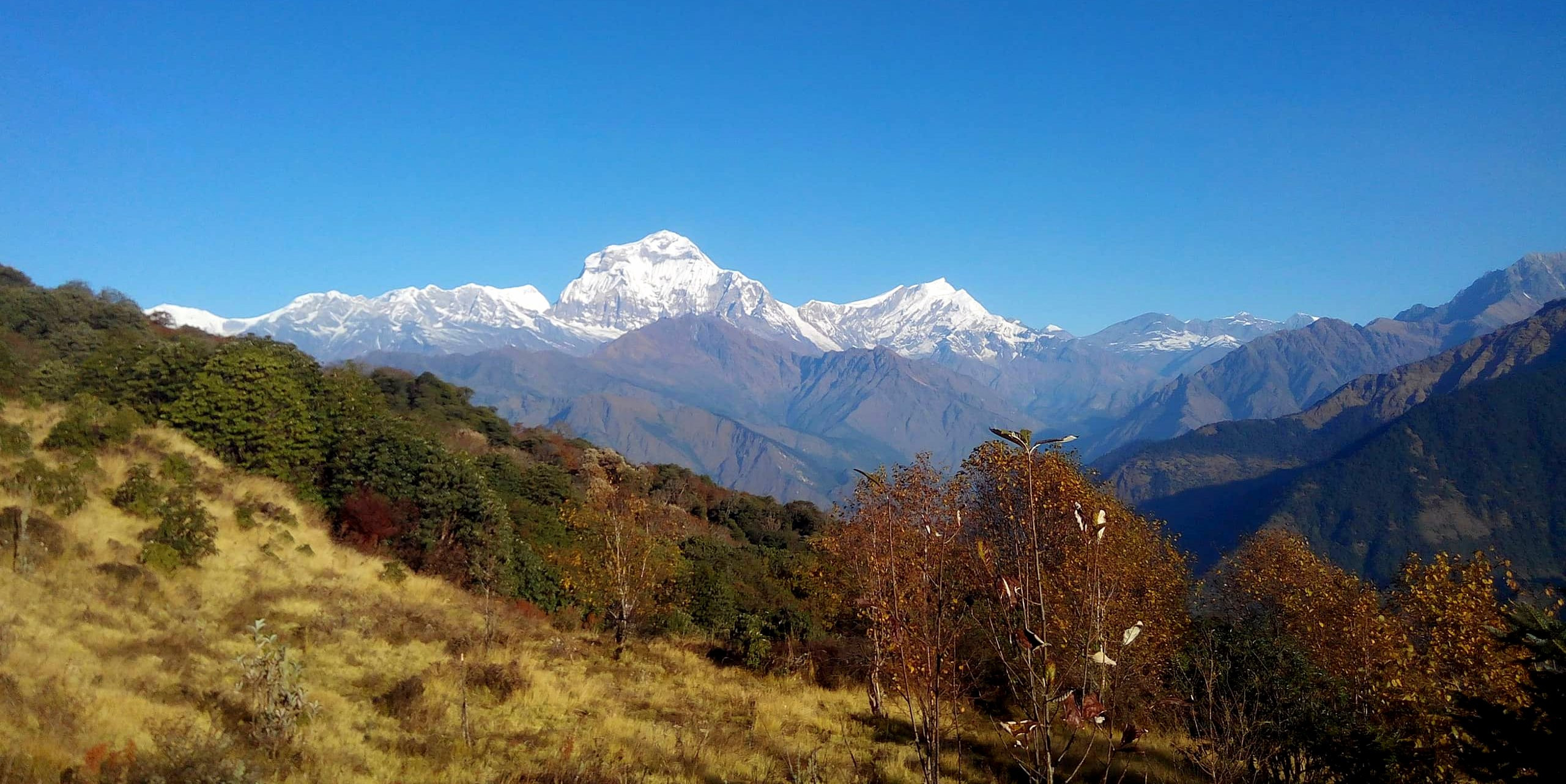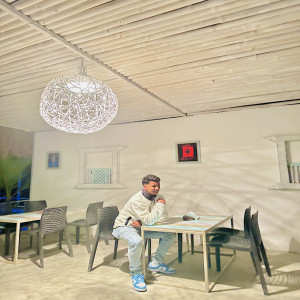Poon Hill Trek
The Poon Hill Trek is one of the most popular and accessible short treks in the Annapurna region of Nepal, renowned for its stunning panoramic views of the Himalayas. This trek is especially famous for the breathtaking sunrise from Poon Hill, where the early morning light bathes the peaks of Annapurna and Dhaulagiri in golden hues.
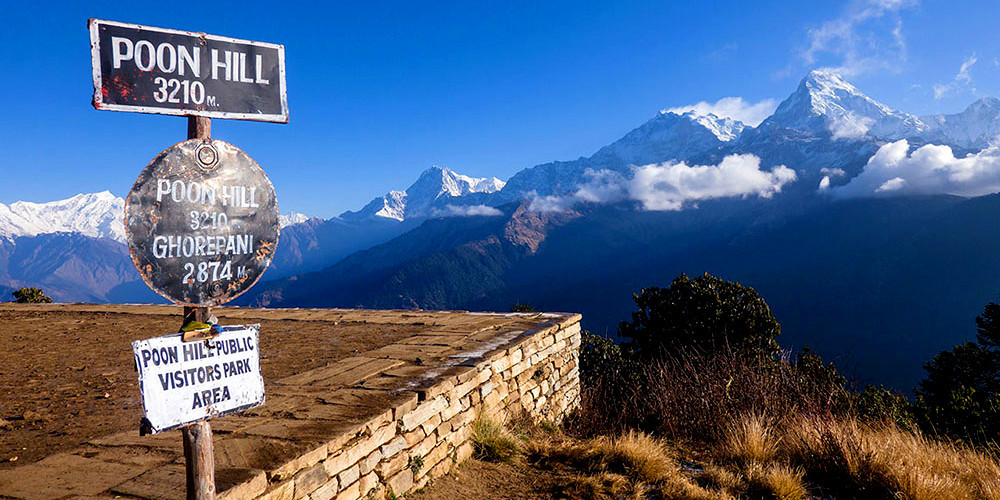
Overview
-
Duration: Typically 4-5 days
-
Difficulty: Moderate
-
Starting Point: Nayapul, about an hour’s drive from Pokhara
-
Highest Point: Poon Hill (3,210 meters or 10,531 feet)
-
Best Season: Spring (March to May) and Autumn (September to November)
Highlights
-
Spectacular Sunrise: The highlight of the trek is the sunrise view from Poon Hill, offering panoramic sights of mountains such as Annapurna South, Annapurna I, Dhaulagiri, and Machapuchare (Fishtail).
-
Rhododendron Forests: In the spring, trekkers can walk through forests ablaze with red, white, and pink rhododendron flowers, which is an iconic sight in Nepal.
-
Gurung and Magar Villages: The trek passes through several charming villages where you can experience the rich culture of the Gurung and Magar communities.
-
Birds and Wildlife: The region is known for its diverse ecology; birds and occasional wildlife sightings add another layer of interest to the trek.
Preparation: The trek is considered moderate and is suitable for most people with average fitness levels. No prior trekking experience is necessary, but some physical preparation can make the journey more enjoyable. Essential items include good hiking boots, a warm sleeping bag, layers of clothing for variable temperatures, and a good-quality backpack. Hiring a guide and porter through a reputable company like ours can enhance your experience, providing insights into the local culture and ensuring a safe journey.
The Poon Hill Trek offers a quintessential Himalayan experience with its stunning mountain views, vibrant cultural encounters, and rich biodiversity, all within a short timeframe. It’s an excellent option for those looking to experience the beauty of the Nepalese Himalayas without committing to a lengthy and strenuous trek.
Dhampus Trek
The Dhampus Trek is an ideal short trek for those looking to experience the beauty of the Nepalese Himalayas over just a couple of days. This trek offers a glimpse into the traditional lives of the mountain communities and provides stunning views of the Annapurna range, including the iconic Machapuchare (Fishtail Mountain). It’s perfect for those who are either short on time or new to trekking and want a manageable yet rewarding experience.
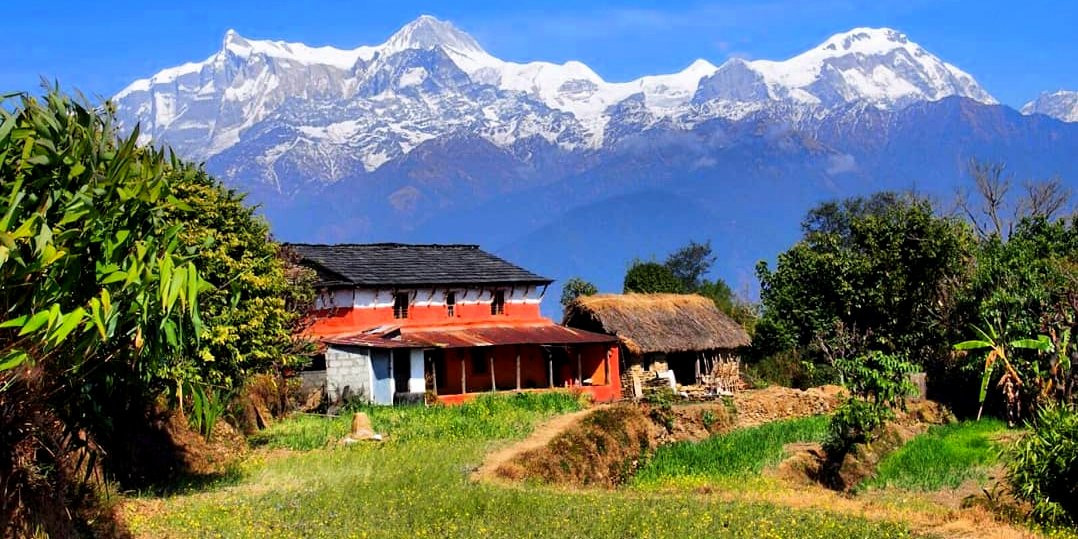
Overview
-
Duration: 1-2 days
-
Difficulty: Easy
-
Starting Point: Phedi, which is a 30-minute drive from Pokhara
-
Highest Point: Dhampus village (1,650 meters or 5,413 feet)
-
Best Season: Spring (March to May) and Autumn (September to November), although it can be done year-round
Highlights
-
Mountain Views: From Dhampus, trekkers enjoy clear views of the Annapurna range, including Annapurna South, Hiunchuli, and Machapuchare.
-
Cultural Experience: Dhampus is predominantly inhabited by the Gurung community, and the trek offers insights into their traditional lifestyles and practices.
-
Accessibility: Due to its proximity to Pokhara and the ease of the trail, this trek can be done by trekkers of all ages and with varying levels of fitness.
Preparation: As this is an easy trek, heavy preparation is not required. Basic fitness is enough to enjoy the walk comfortably. Essential items include comfortable walking shoes, a day pack, water bottles, sun protection, and perhaps a camera to capture the stunning scenery. Staying hydrated and taking it slow will help you enjoy the trek to its fullest.
The Dhampus Trek is a perfect introduction to Himalayan trekking, offering a rich blend of natural beauty and cultural immersion. It's well-suited for families, groups, or individuals looking for a short yet fulfilling outdoor adventure. With its easy accessibility and gentle paths, this trek serves as a quick escape into nature, all within close reach of the conveniences offered by Pokhara.
Mardi Himal Trek
The Mardi Himal Trek is a relatively newer and less frequented trek in the Annapurna region, offering a quieter alternative to the more popular routes. This trek provides stunning close-up views of Mardi Himal, Machapuchare (Fishtail Mountain), and the Annapurna massif, while also allowing trekkers to experience authentic Nepali village life.
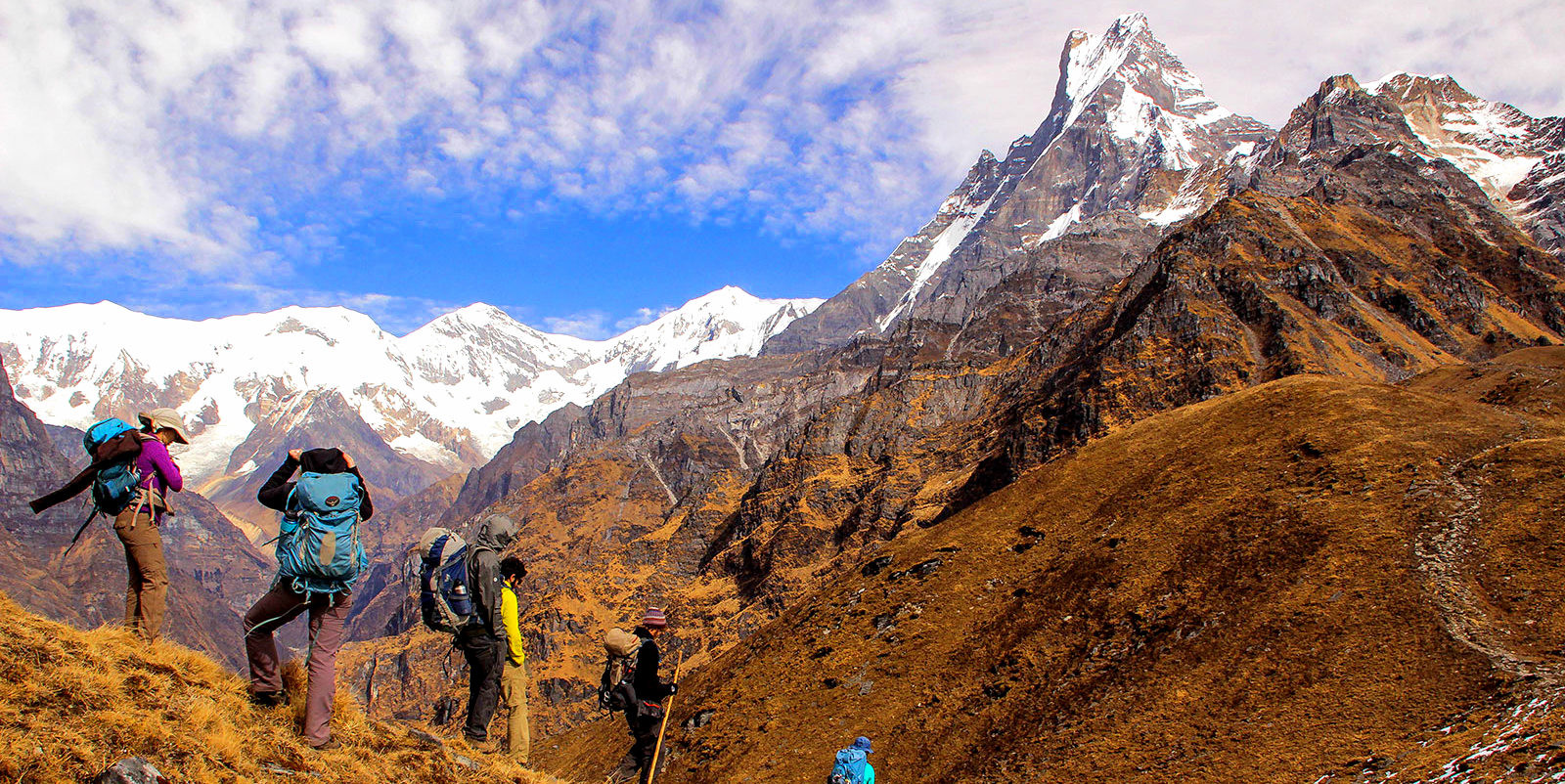
Overview
-
Duration: 5-6 days
-
Difficulty: Moderate
-
Starting Point: Kande, a short drive from Pokhara
-
Highest Point: Mardi Himal Base Camp (4,500 meters or 14,764 feet)
-
Best Season: Spring (March to May) and Autumn (September to November)
Highlights
-
Spectacular Mountain Views: The trek offers excellent views of Mardi Himal, Annapurna South, Machapuchare, and Hiunchuli.
-
Remote Trails: As one of the less traveled paths, the Mardi Himal Trek provides a more secluded and intimate experience with nature.
-
Rich Biodiversity: The route passes through dense rhododendron forests, vibrant in spring, and opens up to rugged high mountain landscapes.
-
Cultural Immersion: The trail goes through traditional Gurung and Tamang villages, offering insights into the daily lives and cultures of local ethnic groups.
Preparation: Trekkers should prepare for moderate difficulty, with some steep and challenging sections, especially close to Base Camp. It's important to be in good physical condition and to pack appropriate trekking gear, including sturdy trekking boots, layered clothing, a warm sleeping bag, and a good quality backpack. Considering the altitude and rugged terrain, it may also be wise to carry a basic first aid kit and altitude sickness pills.
The Mardi Himal Trek is perfect for those looking for a relatively short trek in the Annapurna region that still offers the high-altitude experience of the larger expeditions. It provides a beautiful balance of nature, solitude, and cultural immersion, making it a memorable journey for those seeking both adventure and tranquility.
Australian Camp Trek
The Australian Camp Trek is an excellent option for those looking for a quick and rewarding trekking experience in the Annapurna region of Nepal. Known for its breathtaking views of the Himalayan mountains, this trek is accessible, relatively easy, and can be completed in just 1-2 days, making it perfect for both beginners and those short on time.

Overview
-
Duration: 1-2 days
-
Difficulty: Easy
-
Starting Point: Kande, which is about an hour's drive from Pokhara
-
Highest Point: Australian Camp (2,060 meters or 6,758 feet)
-
Best Season: All year round, with the best visibility typically in the spring (March to May) and autumn (September to November)
Highlights
-
Panoramic Mountain Views: The trek offers spectacular views of the Annapurna South, Hiunchuli, Machapuchare (Fishtail Mountain), and Lamjung Himal.
-
Accessible Adventure: With a starting point just an hour away from Pokhara and an easy trail, it’s a convenient option for a quick trek.
-
Cultural Experience: The trek passes through Dhampus, a village known for its traditional Gurung culture, offering trekkers a glimpse into the lifestyle of the local communities.
Preparation: Given the trek's low difficulty and short duration, extensive preparation is not required. Suitable for all ages and fitness levels, it's important to wear comfortable walking shoes and carry a light backpack with water, snacks, and a basic first aid kit. Dressing in layers is advisable as temperatures can vary significantly from the base to the camp.
The Australian Camp Trek is an ideal trek for those wanting to experience the Himalayas without venturing too far or too high. It offers a perfect mix of natural beauty, easy accessibility, and cultural exposure, all within a short period. This trek is particularly suitable for families, groups, and solo travelers looking for a quick escape into nature.
Royal Trek
The Royal Trek is named after Prince Charles of Wales, who explored this route in the early 1980s along with an entourage of 90 guests. It is one of the least challenging yet scenic treks in the Annapurna region, perfect for beginners or those who prefer a less strenuous trekking experience. The trek provides excellent views of the Annapurna range, without reaching extreme altitudes, making it accessible and enjoyable for all ages and fitness levels.

Overview
-
Duration: 3-4 days
-
Difficulty: Easy
-
Starting Point: Bijayapur Khola, a short drive from Pokhara
-
Highest Point: Syaklung (1,730 meters or 5,675 feet)
-
Best Season: Spring (March to May) and Autumn (September to November)
Highlights
-
Panoramic Views of the Annapurna Range: Despite being a low-altitude trek, the Royal Trek offers beautiful views of Annapurna South, Machapuchare (Fishtail Mountain), Langtang Himal, and Dhaulagiri.
-
Cultural Immersion: The trek passes through various Brahmin and Chhetri villages, providing insights into the rural, yet culturally rich lifestyle of the inhabitants.
-
Historical Significance: The route’s association with British royalty adds a unique historical angle to the trekking experience.
Preparation: The Royal Trek is considered easy and does not require significant physical preparation. Basic hiking gear, including good walking shoes, weather-appropriate clothing, and a daypack for essentials, is sufficient. It's also advisable to carry water purification tablets and some basic first aid supplies.
The Royal Trek is an excellent choice for those interested in experiencing the beauty and cultural fabric of the Annapurna region without the physical demands of higher altitude treks. It offers a peaceful trekking experience with ample opportunities to connect with nature and local traditions, making it perfect for families, first-time trekkers, or those looking for a short yet enriching Himalayan adventure.
Annapurna Short Circuit Trek
The Annapurna Short Circuit Trek is a condensed version of the classic Annapurna Circuit, tailored for trekkers who wish to experience the dramatic scenery and diverse cultures of the Annapurna region in a shorter time frame. This trek still covers some of the key highlights of the full circuit, including the crossing of the Thorong La Pass, one of the highest and most challenging passes in the world.
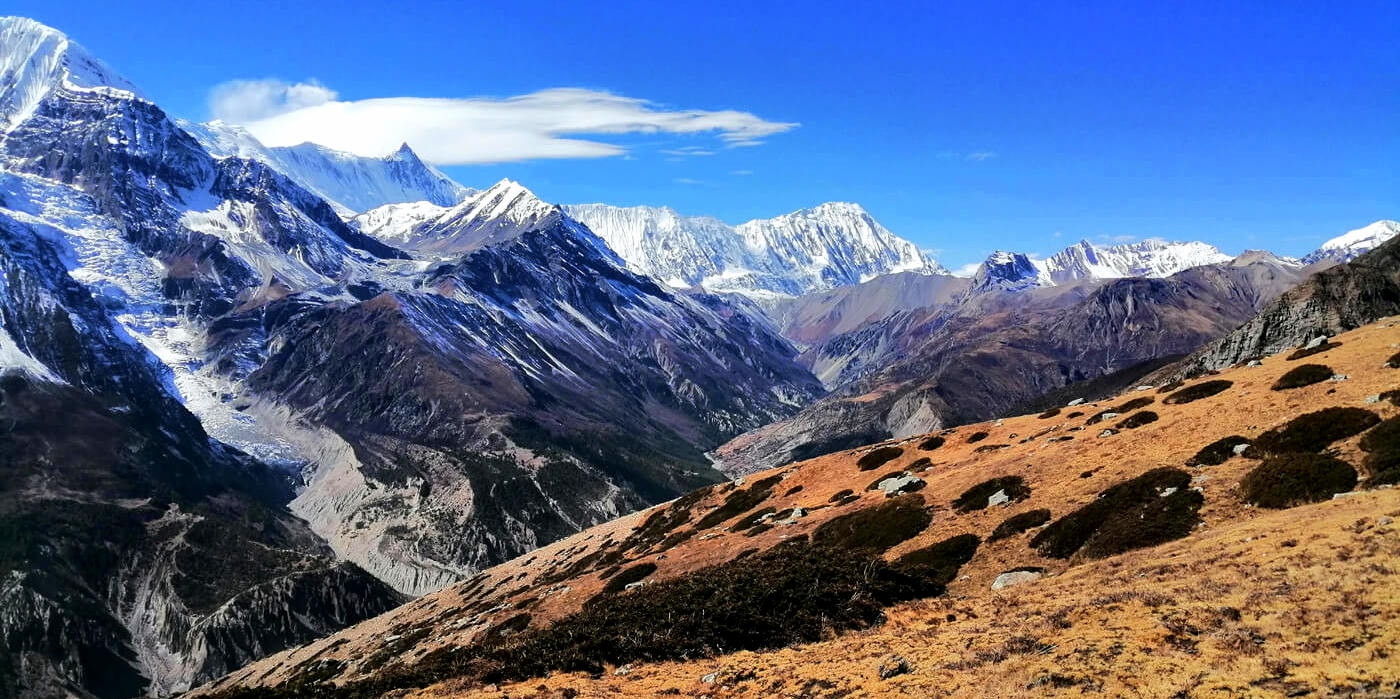
Overview
-
Duration: 10-12 days
-
Difficulty: Moderate to challenging
-
Starting Point: Besisahar, which is about a 6-hour drive from Kathmandu
-
Highest Point: Thorong La Pass (5,416 meters or 17,769 feet)
-
Best Season: Spring (March to May) and Autumn (September to November)
Highlights
-
Diverse Landscapes: From lush subtropical forests and paddy fields to high-altitude tundra and barren landscapes, this trek offers a wide range of natural sceneries.
-
Thorong La Pass: Crossing this high mountain pass is a challenging and rewarding experience, providing spectacular views of the Annapurna massif and surrounding peaks.
-
Cultural Diversity: The trek passes through villages inhabited by diverse ethnic groups, including Gurung, Manangi, and Thakali communities, each with their unique customs and traditions.
-
Sacred Sites: Visit important religious sites such as the Muktinath Temple, a sacred place for both Hindus and Buddhists.
Preparation: Trekkers should prepare for varied and potentially extreme weather conditions and should be in good physical condition to handle multiple days of sustained walking, often at high altitudes. Essential gear includes sturdy trekking boots, thermal clothing, a windproof jacket, sleeping bags rated for cold temperatures, and a good-quality backpack. It’s also wise to bring snacks that can be eaten on the go, water purification tablets, and first aid supplies.
The Annapurna Short Circuit Trek is an excellent option for those seeking the thrill of high-altitude trekking and the cultural richness of the Annapurna region, all condensed into a shorter time frame. It offers an adventurous route filled with breathtaking views, cultural encounters, and the challenge of crossing Thorong La Pass, making it one of the most rewarding trekking experiences in Nepal.
Tips for Short Treks from Pokhara
Short treks from Pokhara can be an exhilarating way to experience the natural beauty and cultural richness of the Annapurna region. Here are some essential tips to help you prepare and make the most of your trekking adventures:
Choose the Right Trek
-
Match Your Fitness Level: Ensure the trek you choose aligns with your physical capabilities and experience. Treks like Poon Hill are suitable for most fitness levels, while others like the Mardi Himal Trek might require a bit more stamina and hiking experience.
-
Consider Your Time Frame: Pick a trek that fits your schedule. Pokhara offers treks ranging from one to several days, so you can find something that fits into your travel plans seamlessly.
Pack Appropriately
-
Essential Gear: Regardless of the trek’s duration, carry good quality hiking boots, a waterproof jacket, a warm layer, and a comfortable backpack.
-
Pack Light: For short treks, minimize your load to essential items like water, snacks, a first-aid kit, and perhaps a camera. Avoid carrying unnecessary weight.
-
Sun Protection: High altitudes mean stronger UV rays, so bring sunscreen, sunglasses, and a hat to protect yourself from the sun.
Stay Hydrated and Nourished
-
Water Intake: Always carry enough water or have means to purify water from natural sources. Staying hydrated is crucial, especially at higher altitudes.
-
High-Energy Snacks: Bring along energy bars, dried fruits, nuts, or chocolate to keep your energy levels up throughout the trek.
Acclimatize Properly
- Take Your Time: If your trek involves high altitudes, allow your body to adjust to the altitude changes. This is especially relevant for treks that go above 2,500 meters.
Respect Local Customs
-
Cultural Sensitivity: Be respectful of local customs and traditions. Dress modestly, ask permission before taking photos, and be polite to residents and fellow trekkers.
-
Environmental Responsibility: Practice Leave No Trace principles by properly disposing of waste and minimizing your environmental impact.
Hire a Guide
- Local Expertise: Especially for beginners, hiring a local guide can enhance your trekking experience. Guides provide valuable insights into the local culture and environment and can help in emergencies.
Check the Weather
- Be Prepared: Weather in the mountains can be unpredictable. Check the forecast before you start your trek and be prepared for sudden changes in weather conditions.
Insure Your Trip
- Travel Insurance: Make sure you have travel insurance that covers high-altitude trekking. This can be invaluable in case of health issues or accidents.
Early Starts
- Maximize Daylight: Start your days early to make the most of daylight hours and enjoy the tranquility of morning treks. This also helps in reaching your destination before afternoon weather changes, such as rain or snow, which are common in the mountains.
Enjoy the Journey
- Take Breaks: Don’t rush your trek. Enjoy the scenery, capture photos, and rest when needed. The journey is as important as the destination.
By following these tips, you’ll be well-prepared to enjoy the stunning landscapes and cultural experiences that short treks from Pokhara have to offer. Happy trekking!
Health and Safety for Short Treks from Pokhara
When planning for short treks from Pokhara, prioritizing health and safety is crucial. Here are some important health and safety tips to consider to ensure a safe and enjoyable trekking experience in the Annapurna region:
Preparation and Fitness
-
Physical Fitness: Ensure you are well-prepared physically for the demands of trekking, even on shorter treks. Regular exercise, such as walking, hiking, or cardio workouts, can help build the necessary stamina.
-
Acclimatization: While short treks generally do not reach extreme altitudes, it’s important to be aware of altitude sickness symptoms if you are going higher than 2,500 meters. Give your body time to adapt to higher elevations by ascending gradually.
Medical Kit and Health Precautions
-
First Aid Kit: Carry a basic first aid kit that includes items such as bandages, antiseptic, blister care, pain relief medication, and any personal medication.
-
Water Purification: Always carry a reliable method to purify water, such as iodine tablets, a water filter, or a UV light purifier. This is crucial to avoid waterborne illnesses.
-
Travel Insurance: Ensure that you have travel insurance that covers high-altitude trekking and medical evacuation in case of emergencies.
Guides and Porters
-
Hire Experienced Guides: Especially for those unfamiliar with the region, hiring a knowledgeable local guide can enhance your safety. Guides can provide valuable information about the trail, weather conditions, and local culture.
-
Respect Porter Welfare: If you hire porters, ensure that they are equipped with adequate gear for the trek and are not overloaded.
Weather Awareness
-
Check Weather Conditions: Weather in the mountains can change rapidly. Check local weather forecasts before starting your trek and prepare for all conditions by packing appropriate gear.
-
Seasonal Considerations: Be aware of the trekking season and typical weather patterns; post-monsoon and pre-monsoon seasons might present different challenges such as slippery trails or snow.
Diet and Hydration
-
Stay Hydrated: Dehydration can be a serious risk, particularly at altitude where it might not be immediately obvious. Drink plenty of water throughout the trek.
-
Eat Well: Consume a balanced diet rich in carbohydrates for energy. Local meals like dal bhat (lentil soup, rice, and vegetables) are nutritious and replenishing.
Clothing and Equipment
-
Appropriate Clothing: Dress in layers to accommodate varying temperatures. Ensure you have a waterproof jacket, thermal layers, and good quality trekking boots.
-
Safety Gear: Depending on the trek, consider bringing safety equipment such as a headlamp, trekking poles, and a whistle.
Cultural Sensitivity and Environmental Awareness
-
Respect Local Traditions: Be respectful of local customs and religious practices. This includes dressing modestly and asking permission before taking photographs of local people.
-
Leave No Trace: Adhere to Leave No Trace principles to minimize your environmental impact. Carry out all waste, use biodegradable products, and stay on marked trails.
Communication
-
Stay Connected: While many areas in the Annapurna region have mobile reception, it can be spotty. Consider renting a satellite phone if you are going on more remote trails.
-
Inform Someone of Your Plans: Always let someone know your trekking itinerary and expected return time.
By taking these health and safety precautions, you can help ensure that your trekking experience is safe, enjoyable, and culturally enriching.
Best Time for Short Treks from Pokhara
The best time for short treks from Pokhara is largely determined by the weather conditions in the region, which play a significant role in both the enjoyment and safety of the trek. The two most favorable seasons for trekking in the Annapurna region around Pokhara are spring and autumn. Here’s a closer look at each:
Spring (March to May)
-
Weather: Spring is one of the best times for trekking as the weather is generally stable and warm, with clear blue skies that offer excellent visibility. Temperatures are comfortable during the day, though nights can still be chilly, especially at higher altitudes.
-
Nature: This season is also particularly beautiful as the landscapes come alive with blooming flowers, especially rhododendrons, Nepal's national flower, which paints the hills in vibrant colors.
- Trail Conditions: Trails are usually dry and less slippery, making it safer and more comfortable to trek.
Autumn (September to November)
-
Weather: Autumn is considered the peak trekking season in Nepal due to its ideal weather conditions. Like spring, the skies are typically clear, providing excellent mountain views and pleasant daytime temperatures.
-
Nature: The post-monsoon freshness adds a lush vibrancy to the forests and valleys. The clear skies following the rainy season offer some of the best visibility of the year.
-
Trail Conditions: Trails are generally in good condition, having been washed clean by the monsoon rains, though they can be busy as this is the most popular season for trekking in Nepal.
Other Considerations
-
Monsoon (June to early September): Trekking during the monsoon is less ideal as the heavy rains can lead to slippery trails, leeches, and obscured mountain views. However, the rains are usually concentrated in the afternoon and evening, so morning treks can still be enjoyable. The region around Pokhara receives less rain compared to other parts of Nepal, which might still make shorter treks feasible.
-
Winter (December to February): Winter treks are possible, especially for shorter routes around Pokhara where the snowfall is not as intense as in the high mountains. The skies are clear and the views are spectacular, but temperatures can be very cold, particularly in the morning and at night, so proper winter gear is essential.
Choosing the right time for your trek depends on what you’re looking for in terms of weather, scenic beauty, and trail conditions. Spring and autumn offer the best overall conditions for enjoyable and safe trekking experiences.
Pokhara is the perfect starting point for accessing some of the most picturesque and manageable short treks in the Himalayas. Whether it's the breathtaking views from Poon Hill, the cultural richness of Dhampus, or the serene paths of the Mardi Himal, each trek offers its own unique charm and adventure. Ideal for both beginners and experienced trekkers with limited time, the best seasons for these treks are during the spring and autumn months, which provide favorable weather and vibrant landscapes. Proper preparation, respect for local customs, and environmental consciousness are essential for a rewarding trekking experience. With these considerations in mind, short treks from Pokhara promise unforgettable journeys through some of the most stunning scenery in the world.
FAQs for Short Treks from Pokhara
Q: What are the best short treks from Pokhara?
A: The top recommended short treks from Pokhara include the Poon Hill Trek, the Dhampus Trek, the Mardi Himal Trek, the Australian Camp Trek, and the Royal Trek. Each provides unique scenic and cultural opportunities.
Q: How physically demanding are these treks?
A: Difficulty varies by trek. The Poon Hill and Australian Camp treks are moderately challenging, suitable for most fitness levels. The Mardi Himal Trek is more demanding, with steeper paths and higher elevations.
Q: What is the best time of year to go on these treks?
A: Optimal trekking times are spring (March to May) and autumn (September to November), featuring clear, dry weather for the best views and comfortable trekking conditions.
Q: Do I need a guide for short treks from Pokhara?
A: While not mandatory, a guide is strongly recommended to enhance safety, provide local knowledge, and assist in navigating the trails and local culture.
Q: What should I pack for a short trek?
A: Essential items include sturdy trekking shoes, layered clothing for varying weather, a waterproof jacket, sun protection, a water bottle, and a basic first aid kit.
Q: Are permits required for these treks?
A: Yes, treks in the Annapurna region typically require an Annapurna Conservation Area Permit (ACAP) and a Trekkers' Information Management System (TIMS) card, available in Kathmandu or Pokhara.
Q: How do I manage food and lodging on the trek?
A: Most routes offer tea houses that provide meals and lodging. It's also wise to carry snacks for energy boosts between stops.
Q: What are the risks involved in these treks?
A: Common risks include altitude sickness, dehydration, and minor injuries such as sprains. Always monitor the weather, stay hydrated, acclimatize appropriately, and have first aid supplies ready.
Q: Can I do these treks with children?
A: Yes, treks like the Australian Camp Trek and Dhampus Trek are suitable for children, thanks to their lower difficulty levels and shorter durations. Make sure children are properly prepared.
Q: How do I get to the starting point of these treks?
A: The starting points are typically accessible by a short drive from Pokhara, with local taxis or trekking companies providing transportation as part of their services.
For the Nepal tour, please click here.
If you are looking for different kinds of Nepal Tours or Trekking Packages, feel free to contact us.
